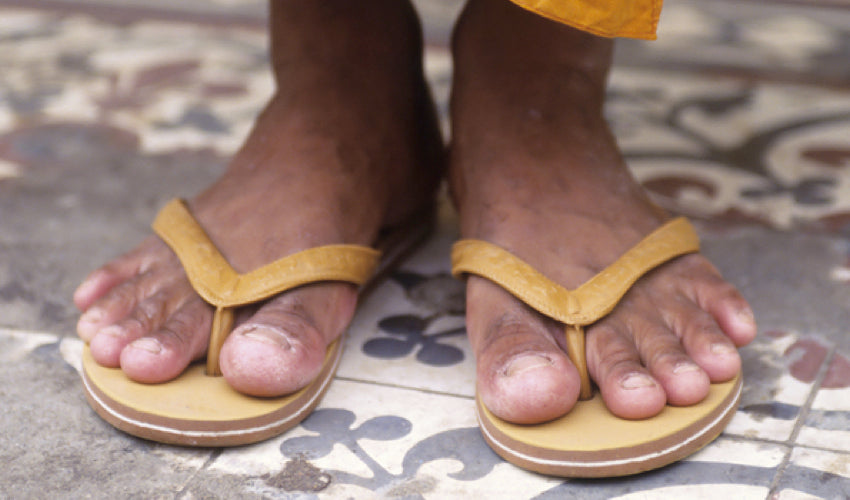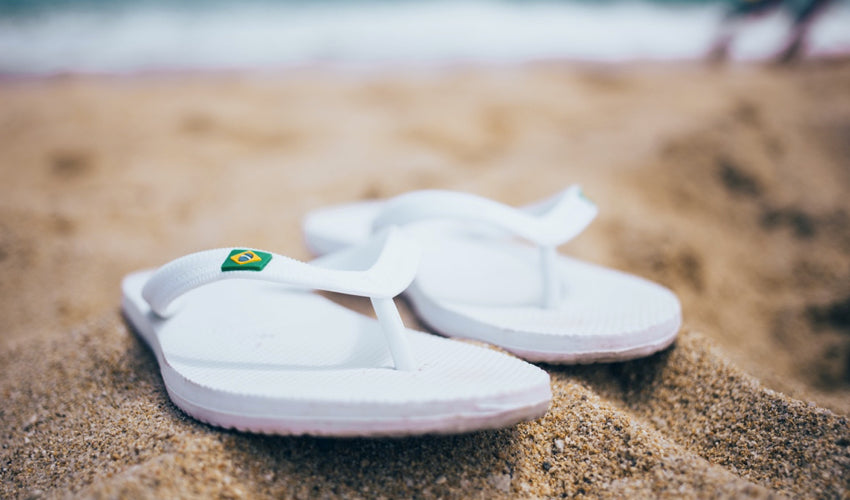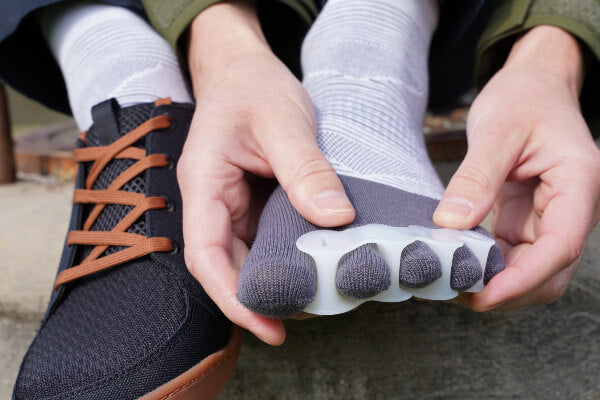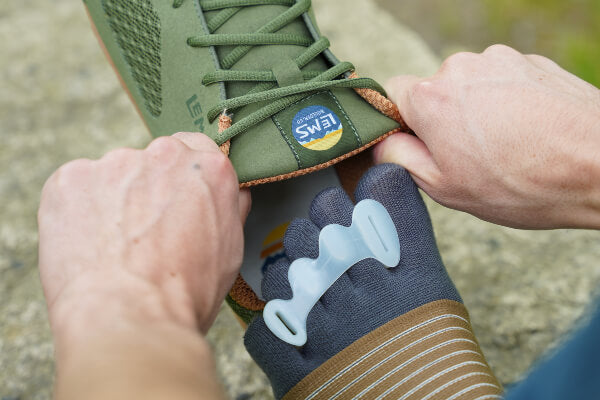How to Use Correct Toes With Thong Sandals & Flip-Flops

Correct Toes toe spacers can work well in combination with a variety of footwear, including thong sandals and flip-flops. This insightful video shows you how to use... Read more

The flip-flops discussion—are they healthy, are they not—seems to come up every year once the weather turns nice. There are wide-ranging opinions on the merits and pitfalls of flip-flops for foot health, and many healthcare professionals possess strong views on this ubiquitous warm weather footwear. In fact, the topic of flip-flops often generates a lot of controversy, seemingly out of proportion with the simple and straightforward nature of this subject matter. In this article, we’d like to share our viewpoint and stance on flip-flops and how this stripped-down, minimalist footwear option might contribute to or hinder foot health.
So, are flip-flops bad for your feet?

Any conversation about flip-flops and foot health should begin with a review of foot-healthy shoe design features. This criteria differs based on who you poll, but in our experience, we’ve found the following design features to be foot-health-positive:
We’ve also found that the less “technology” a shoe possesses, the better it is for the foot because the foot—in almost all instances—is inherently strong and stable if it’s allowed to function in the manner that nature intended. An additional feature we like to see in footwear is an open upper that allows your foot and toes to be exposed to light and air, as this helps to promote a healthier environment for your foot. Obviously, not all climates are conducive to this last design feature, but most regions can accommodate foot exposure for at least a portion of the year.
So, if we take each of these points into consideration, flip-flops do indeed meet all of our criteria for what constitutes foot-healthy footwear. Flip-flops, in most cases, and for most people, represent an opportunity to build foot strength and prevent a lot of the chronic foot problems that plague our shod society, although some caveats do exist (please see the section below entitled “Where Problems Might Arise”).

Digging into various online discussions and even the literature, it’s not difficult to find articles and even a few studies admonishing flip-flops for being harmful footwear. But, as is so common in the world of laboratory research, you can also find studies that state the opposite. The seemingly equivocal nature of conventional research into this topic creates confusion for those interested in making the most informed decision. The best thing any consumer or health advocate can do is to look at the current evidence (both experimental and empirical) and make the best possible decision based on all the available findings.
Let’s take a closer look at one of those studies that inadvertently landed on the side of flip-flops. This study, supported by the National Institutes of Health, was conducted by Dr. Najia Shakoor and published in the journal Arthritis Care & Research. Shakoor’s study, entitled “The Effects of Common Footwear on Joint Loading in Osteoarthritis of the Knee,” examined the effects of several common shoe types on knee loading in subjects with osteoarthritis of the knee, including clogs, athletic “stability” shoes, flat walking shoes, and flip-flops. The author states the following:
We know barefoot is good for your knee load from previous studies [please see our article entitled Footwear & Knee Osteoarthritis for more on this study]. Then we thought, do different shoes have different effects on the knee?
And so Shakoor and her team compared the above-mentioned shoes with going barefoot in terms of the amount of force upon the knee while walking. Here is what Shakoor had to say about the findings of her study:
The shoes that we intuitively recommend to our patients [with knee arthritis] and thought might be best—stability shoes and clogs—were associated with the highest load. Flat walking shoes, barefoot, and flip-flops were essentially the same in load on the knee. But clogs and stability shoes result in a 15% higher load.
Shakoor goes on to say this:
These are just initial studies, and it's too early to recommend [changes]. But several studies are suggesting that perhaps flat, flexible footwear may help decrease loads on the knee compared to footwear that is less flexible and has higher heels. Stability shoes have higher heels [than other athletic shoes]. We think it's the flatness and the flexibility that may provide the benefit.
This comment by Shakoor will resonate with those who are already familiar with Natural Footgear’s foot health philosophy. Other relevant articles we have published that relate to the topic of what constitutes a foot-healthy shoe include What is Natural Arch Support?, What Makes for a Great Hiking Boot?, and The Shoe Cushioning Myth.

Flip-flops, in one form or another, have been a part of our human civilization for millennia. In our contemporary society, we tend to look to research studies to tell us what’s truthful or valid. In doing so, we sometimes overlook the empirical evidence that exists around us, including certain health traditions or behaviors that have been practiced for thousands of years. It’s extremely important to give serious consideration to the practices and health habits that appear to have served so many so well throughout the ages, even if our current default mode is to rely most heavily on randomized controlled trials and clinical studies to determine the merits of a particular idea or approach.
Flip-flops have been used (and continue to be used) by hundreds of millions of people on continents such as Asia, Africa, and South America. I’ve personally had the great privilege of spending a total of 7 months in South and Southeast Asia over the span of three trips, including time in Nepal, India, Sri Lanka, and Indonesia. This time, especially my experience in Nepal, was revelatory to me in terms of the footwear I observed and its apparent effects on foot anatomy and foot health. Among the many wearers of flip-flops and other similar footwear I met throughout the developing world (including mountain porters in the High Himalayas), I observed in this large group both incredible foot structure and foot health. In fact, on the trekking routes of Nepal, the only people complaining about aching, painful feet were Westerners, in their stiff, heavy hiking boots.

Many people who argue that flip-flops are detrimental to foot health have not visited the developing world and witnessed, firsthand, just how commonly (and successfully) this footwear option is used, without the widespread foot health issues we experience in our society. The American Podiatric Medical Association notes that 77 percent of US adults have experienced foot pain or problems, whereas this study conducted in China and India back in 1949 noted that only 9 percent of the thousands of people studied—some who had never worn shoes, some who had worn only “a light, flat and very pliable sandal”—experienced foot problems (and most of those problems were dermatological issues, not musculoskeletal issues).
The following logic is intended to demonstrate why flip-flops are not the harmful footwear they are often made out to be:
Flip-flops are used en masse in the developing world. The foot health issues that plague shod Westerners are significantly lower in these societies. If flip-flops do indeed contribute to a breakdown in feet and foot health, we would expect to see large swathes of people in the developing world hobbled by them. This is clearly not the case.
So, real-world observations into footwear and foot health are valid too. When it comes to health issues, including foot issues, it's extremely important to do your own investigating and challenge long-held beliefs and assumptions. Sometimes it turns out that we had it right all along; other times it turns out that a paradigm shift is required.

Our perspective on flip-flops is that they can be foot-health-positive, provided certain criteria or conditions are met. First, and perhaps most importantly, the strapping system on your flip-flop must be sufficiently snug to prevent slippage of the sandal under your foot. One of the biggest complaints about this kind of footwear from healthcare professionals is that too-loose flip-flops can result in an excessive amount of toe flexion or gripping to keep the sandals on. And, indeed, this is a legitimate concern and a potential problem. In this scenario, with a loose strapping system around the forefoot, the foot is not capable of acting as nature intended, and repetitive toe gripping can lead to unanticipated (and undesirable) foot and toe problems. It’s best to find a pair of flip-flops that fits snugly around your forefoot to prevent repetitive toe gripping. Or better yet, select a men’s or women’s sandal that possesses a heel strap to keep your foot firmly rooted in place on your sandal's footbed:
SHOP MEN'S SANDALS SHOP WOMEN'S SANDALS
Another possible problem associated with flip-flops is that not all flip-flops are created equal when it comes to their design. Many flip-flops have heel elevation, rigid soles, and toe spring, among other problematic design elements. The same criteria that apply to regular shoes (in terms of foot-healthy design features) also apply to flip-flops. It’s always a good idea to come back to the foundational concepts of what constitutes a truly foot-healthy shoe when shopping for footwear, including flip-flops.
Also, most of us wear closed-toe shoes or boots during the cooler months before adopting more airy options in the warmer months. This transition can sometimes be abrupt, especially for those individuals who go from a conventional shoe with heel elevation to a pair of flip-flops that possess little or no heel elevation. Achilles tendon issues are one possible outcome of this rapid transition. The main point here is that the transition to wearing flat-soled flip-flops should be a gradual one so that your body can adapt slowly and minimize the risk of an injury. Our article entitled How to Transition to Minimalist Shoes offers some insightful tips for those who are transitioning from cold weather footwear to flip-flops.
One final consideration with flip-flops is the importance of respecting the structural limitations of this minimalist footwear. In most cases, flip-flops were not created to be used in adventurous or high-intensity situations. This footwear option generally works best in low-intensity situations, such as at the beach, around the house, or for casual trips around town. Once the footbed wears down, it’s important to introduce a new pair as soon as possible so that you can avoid the problems associated with aging footwear.

So, where do flip-flops rank on the scale of foot-healthiness? I think the answer largely depends on the specific design features included in the sandal and whether or not the strapping system is sufficiently snug. I think it also depends on the state of readiness of the user to wear this flat and flexible sandal. If the criteria for foot-health-positive design features are all satisfied, and if the transition to this type of minimalist footwear is gradual and measured, then flip-flops can indeed be a viable (and valuable) warm weather footwear option that allows your foot to function as nature intended. And that's a good thing! When your foot functions as nature intended, it means that your toes are well splayed, your intrinsic foot muscles are strong and balanced, and your main foot arch—your medial longitudinal arch—is strong and stable on its own, all of which help you avoid pain and problems.
I hope this article has provided you with an alternative perspective to most of the content out there about flip-flops and their possible effects on feet and foot health. Ultimately, the decision of what you choose to put on your feet is yours, and I wish you success with whatever you deem to be in the best interests of your own foot’s form and function.
Disclaimer:
The above content is for educational or informational purposes only and is not intended to replace or augment professional medical instruction, diagnosis, or treatment. Read full disclaimer here.$65.00
$10.00
$80.00
$80.00
$50.00
$50.00

Correct Toes toe spacers can work well in combination with a variety of footwear, including thong sandals and flip-flops. This insightful video shows you how to use... Read more

Correct Toes toe spacers work well in combination with huaraches minimalist running sandals. Huaraches are a type of footwear worn by the Tarahumara—an indigenous group living in... Read more


I once saw a young Indian woman, whose big toe was far-away splayed away from her other toes — the space between her big toe and the others was cut-into by her flip-flops — probably a result of standing on a slope often in wet weather, or wearing flip-flops in wet, slippery weather in general. The thing is, no matter what you have on your feet, you need to be mindful of them for them to stay healthy.
Hello, Helene,
Thank you for your response. We could not agree more! Mindfulness is the main ingredient to honoring what your body needs, from the feet on up. Thank you for contributing to the ongoing conversation we are honored to moderate.
Continued best,
Sarah K. Schuetz
In transitioning to minimalist footwear, some of your articles recommend barefoot walking, including around the house. However, I’m wondering if it is okay to walk on a hard surface on which there is no carpeting?
Hi, Lawrence,
Thank you for your message. I’m glad to hear that you’re thinking about ways to strengthen and rehabilitate your feet.
The human foot is naturally very adaptable and responsive and can support our weight and movements on a variety of surfaces, including hard surfaces. This is, however, under ideal circumstances (i.e., an already strong and resilient foot). Many folks who suffer from the foot problems caused by conventional footwear may have trouble with harder surfaces initially. My best recommendation is to check out the following article, which outlines the many ways to support a transition to healthier feet and footwear:
www.naturalfootgear.com/blogs/education/17888528-how-to-transition-to-minimalist-shoes
In general, it’s always wise to start out slowly and gradually, and that would certainly apply to walking barefoot on harder surfaces.
If you have any additional questions, please do let us know. We’re happy to help out however we can!
Kind regards,
Marty Hughes, DC
I have always loved flip-flops, even when hiking. I’ve owned great flip-flops and really crappy ones, for various reasons. Why don’t you sell them? I’m talking about the traditional flip-flop, without the heel strap. A good pair, made by folks who comprehend healthy footwear, is not that easy to find, in my experience. Cheers!
Hi, Steve,
Thank you for your comment! It’s great to hear from other people who have successfully used flip-flops for a variety of purposes, including hiking. Though we do appreciate the many merits of a good-fitting flip-flop, we’re partial to minimalist sandals that incorporate a heel strap. We just find that the heel strap makes the sandal that much better for active outdoor use.
Kind regards,
Marty Hughes, DC
I have Morton’s neuroma in both my feet and wearing closed-in shoes is really uncomfortable. I moved to a warmer climate where I can wear flip-flops all year round—problem solved!!
Greetings, Una,
Thank you for posting your comment! I’m really glad to hear that you’ve found relief from your neuroma-related pain through the use of flip-flops. Excellent!
If you do ever opt to reincorporate closed-toe shoes into your life, you might consider checking out the following resources from our site, which I think you’ll find quite helpful:
www.naturalfootgear.com/blogs/educational-articles/how-to-shop-for-shoes
www.naturalfootgear.com/blogs/educational-articles/neuromas-conventional-vs-natural-approaches
All the best,
Marty Hughes, DC
At 84 years old, I find wearing flip-flops is the best way to eliminate my Morton’s neuroma pain in both feet. Now I am looking for a good pattern for hand-knit flip-flop socks. I love Lems shoes!
Thank you for your comment, Joan! We’re glad to hear that you’re doing well in your minimalist footwear. Wishing you all the best for continued success!
Kind regards,
Marty Hughes, DC
I live in New Zealand, so wearing flip-flops is normal for so many here. I worked in construction on a sloping section, working in safety boots for days. I found my Achilles tendon was so tight, and then wearing flip-flops caused problems. Reading your post about transitioning makes sense, but it’s so often overlooked. Very good information, guys!
Thank you for your comment, Graham! And thank you for your kind words. We hope that you’re enjoying excellent foot health and that you’re no longer experiencing any Achilles tendon issues.
All the best,
Marty Hughes, DC